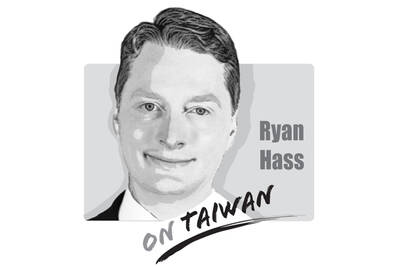Hundreds of people were left with severe burns after an explosion of colored powder that set off a fire during the “Color Play Asia” party at the Formosa Fun Coast (八仙海岸) water park in New Taipei City’s Bali District (八里), and scores remain in critical condition. It was a grim lesson in how a disregard for public safety can have devastating results.
The exact reason for the high-density cornstarch explosion is still unknown, with some suggesting that smoking, a short circuit or heat produced by lighting or sound equipment ignited the substance. However, what is clear is that those involved in organizing the event had no regard for safety.
Color Play (玩色創意) head organizer Lu Chung-chi (呂忠吉) said, after being questioned by prosecutors on Sunday night, that the event staff were not informed that the powder was flammable. Apparently there were not any “no smoking” signs around the stage and cigarette butts were everywhere.
Considering Lu is said to understand that an activity creating dust is a combustible dust explosion hazard and that cornstarch is a potential fire hazard, the gross negligence he showed is appalling.
Amid safety concerns about events where colored powder is sprayed about, which Lu introduced in Taiwan in 2013 and that have grown increasingly popular, he had said on several occasions that the reason Color Play uses cornstarch, as opposed to other materials, is that fine corn flour is safe and harmless to the environment.
Lu also posted a statement on the company’s Web site to alleviate fears, saying that the coloring it adds to the cornstarch is edible and thus unlikely to cause explosions, and that cornstarch would be unlikely to cause explosions unless a very high density of the powder is exposed to extreme heat in a confined space.
The calamity might have been avoided had Lu warned staff that spraying large amounts of the powder in close proximity to electrical sources is dangerous, and if smoking had been banned to prevent a possible dust explosion. He should also have acknowledged that selling about 4,000 tickets for an event which could only accommodate 600 people was a safety risk.
It is a common assumption among Taiwanese that potential problems are unlikely to materialize or, if they do, the consequences are unlikely to be severe enough to merit preventive measures. That is one reason an event like this, which attracted more than 1,000 spectators, or others on a much larger scale, are held without organizers having effective emergency plans.
The chaotic scene of victims waiting hours for ambulances without first aid treatment, the lack of emergency medical resources, such as personnel and equipment, the hospitals’ struggle to cope with the sudden influx of victims and the failure to provide relatives with timely and accurate information on victims have all cast doubt on the nation’s capability to effectively carry out a massive rescue operation.
Yesterday afternoon, about 44 hours after the explosion, a mother, whose 20-year-old daughter is the first casualty, cried out for help because her 12-year-old son, suffering burns to over 80 percent of his body, is still at a hospital that lacks facilities to treat burn patients. Her daughter was finally admitted to a hospital with a burn center nine hours after the explosion after she was turned away by other hospitals. The chaos caused by the carelessness of certain individuals is beyond imagination.
Life is fragile and public safety cannot be assured by empty words.

China has not been a top-tier issue for much of the second Trump administration. Instead, Trump has focused considerable energy on Ukraine, Israel, Iran, and defending America’s borders. At home, Trump has been busy passing an overhaul to America’s tax system, deporting unlawful immigrants, and targeting his political enemies. More recently, he has been consumed by the fallout of a political scandal involving his past relationship with a disgraced sex offender. When the administration has focused on China, there has not been a consistent throughline in its approach or its public statements. This lack of overarching narrative likely reflects a combination
US President Donald Trump’s alleged request that Taiwanese President William Lai (賴清德) not stop in New York while traveling to three of Taiwan’s diplomatic allies, after his administration also rescheduled a visit to Washington by the minister of national defense, sets an unwise precedent and risks locking the US into a trajectory of either direct conflict with the People’s Republic of China (PRC) or capitulation to it over Taiwan. Taiwanese authorities have said that no plans to request a stopover in the US had been submitted to Washington, but Trump shared a direct call with Chinese President Xi Jinping (習近平)
Heavy rains over the past week have overwhelmed southern and central Taiwan, with flooding, landslides, road closures, damage to property and the evacuations of thousands of people. Schools and offices were closed in some areas due to the deluge throughout the week. The heavy downpours brought by the southwest monsoon are a second blow to a region still recovering from last month’s Typhoon Danas. Strong winds and significant rain from the storm inflicted more than NT$2.6 billion (US$86.6 million) in agricultural losses, and damaged more than 23,000 roofs and a record high of nearly 2,500 utility poles, causing power outages. As
The greatest pressure Taiwan has faced in negotiations stems from its continuously growing trade surplus with the US. Taiwan’s trade surplus with the US reached an unprecedented high last year, surging by 54.6 percent from the previous year and placing it among the top six countries with which the US has a trade deficit. The figures became Washington’s primary reason for adopting its firm stance and demanding substantial concessions from Taipei, which put Taiwan at somewhat of a disadvantage at the negotiating table. Taiwan’s most crucial bargaining chip is undoubtedly its key position in the global semiconductor supply chain, which led